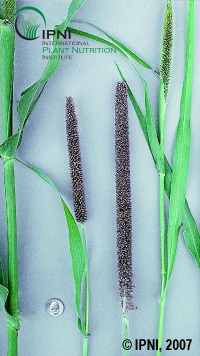Pearl Millet
Adaptation
- Entire state.
- Best on sandy soils.
- Very tolerant of drought and acid soils.
Establishment
Seed in April (i.e., whenever soil temperatures at 2” depth reach 65o F) - June. See Establishment of Warm Season Annual Grasses for more details.
In-Depth
 Pearl Millet originated in Africa and is the most widely planted summer annual grass in Georgia. This tall growing, erect annual grass produces several stems from a central plant. As a result, it requires at least 6 – 8 in. of stubble to regrow. Improved varieties can produce over six tons per acre. Even under moderate drought conditions, these varieties will rarely yield less than four tons per acre.
Pearl Millet originated in Africa and is the most widely planted summer annual grass in Georgia. This tall growing, erect annual grass produces several stems from a central plant. As a result, it requires at least 6 – 8 in. of stubble to regrow. Improved varieties can produce over six tons per acre. Even under moderate drought conditions, these varieties will rarely yield less than four tons per acre.
Pearl millet can be grazed or harvested as hay or silage. Researchers at Tifton have found that pearl millet grazing should begin when plants reach 20 – 24 in. height, but regrowth rate and animal performance is best if a 9 – 12 in. stubble height is maintained. Pearl millet can make good quality hay if cut when plants reach 2 – 3 ft tall. This prevents the forage from maturing beyond the boot stage and therefore being too mature to provide high quality. The drying rate of millet hay can be sped up by the use of a roller/crimper-style conditioner.
If harvested prior to advanced maturity stages, the range of total digestible nutrients (TDN) can be expected to be 52-58%, while crude protein (CP) will range from 8-11%. There is some evidence to suggest that seeding rates at the high end of the recommended ranges will promote a higher leaf:stem ratio. This may improve forage quality, but these gains may not compensate for the expense of the higher seeding rate.
Since pearl millet does not produce prussic acid, this species has a distinct advantage over sorghum, sudangrass, and sorghum x sudangrass hybrids. This allows pearl millets to be grazed or harvested at any growth stage and during droughts without the risks associated with prussic acid poisoning. However, pearl millets can have high nitrate levels.
Millet produces good quality forage and supplies grazing from June through August (Figure 10). Millet planted in spring (April) should be ready for grazing 30 – 40 days after planting and should be productive for 80 – 110 days. The crop is most productive during the first 60 days of the life of the stand. Well-fertilized millet should carry three to four stocker cattle or two to three mature cows per acre during the first 60 days. Lower the stocking rates during the last part of the grazing season. Even out the grazing supply over the summer by making multiple plantings. Plantings made in early June will be in peak production when April plantings are starting to decline in productivity.
Several hybrid millets are marketed in Georgia. Some hybrids are tall-growing and produce high yields. Other hybrids are dwarf, low-growing millets that are excellent for grazing. Dwarf millets produce leafy forage and will provide higher average daily gains than the taller hybrids. Newer dwarf millet varieties are also resistant to Pyricularia leafspot, which can reduce millet yields in late summer. New varieties of brown mid-rib (BMR) pearl millets are available from some suppliers. These have not been excessively assessed for forage yield or quality potential, but current research is being conducted at UGA.
Information about recommended varieties of pearl millet may be found above in the "At-A-Glance" summary.
Dr. Dennis Hancock
Forage Extension Specialist
Crop & Soil Sciences Dept.
